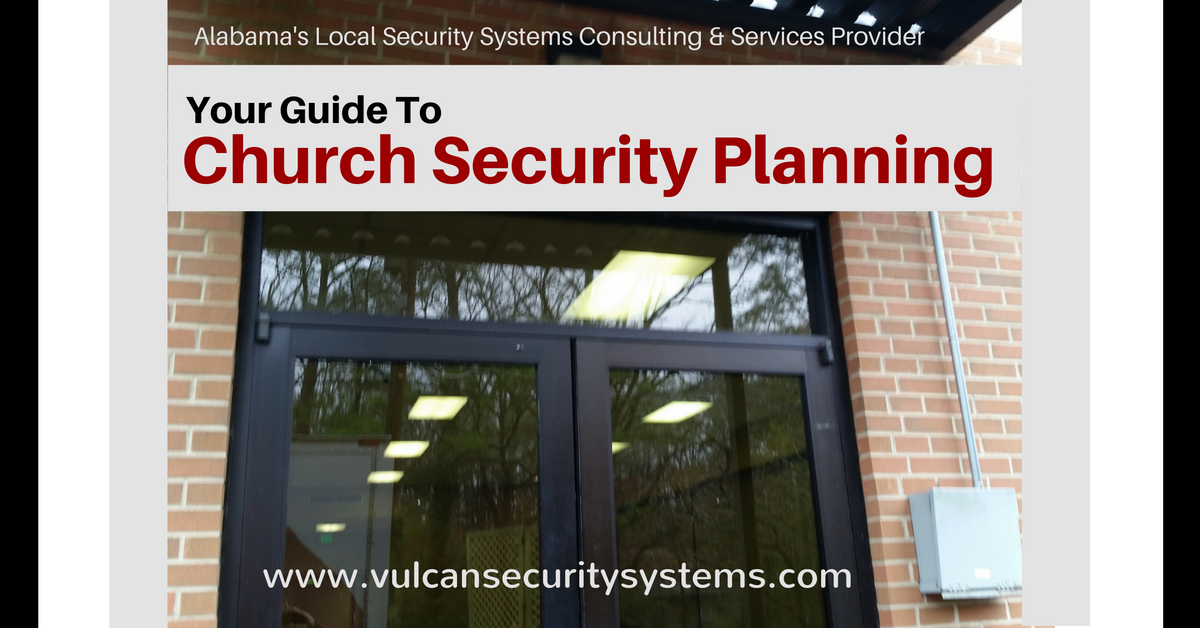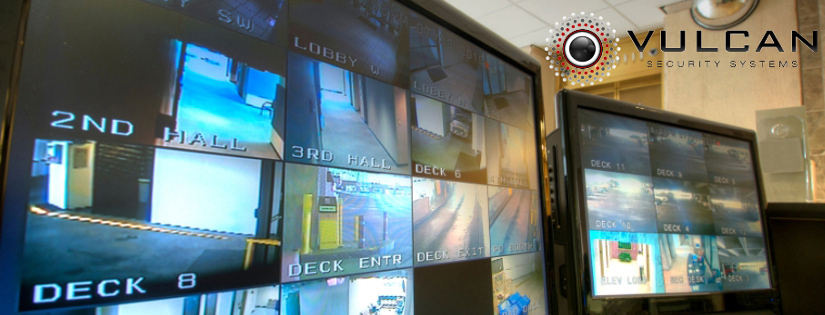A comprehensive and 360-degree approach to church security planning and implementation will help you get the most out of the resources you have available to devote to security.
In this post and the companion video presentation, Vulcan Security Systems CEO Jason Maddox offers a detailed look at church security planning including recent trends in organization security, developing a team or committee to oversee your security needs, technology options, communication planning, the human side of security systems implementation and staffing—and more.
This post and video webinar are based on a presentation CEO Jason Maddox gave to the Central Alabama Chapter of the National Association of Church Administrators a few years ago and includes takeaways from the security system implemented by one of Vulcan Security Systems client churches.
We offer free initial consultations to churches across Alabama who are looking to enhance security for their churches through access control and lockdown technology, emergency notification options (like “panic” buttons), video security and premises monitoring.
Phone: 205-290-9404
Email: info@vulcansecuritysystems.com
To view the slide deck and/or video webinar version of this post, please scroll to the bottom of the page.
Trends in Organizational Security
There’s a renewed emphasis on security in terms of planning, training, and technology investments.
Every organization needs to develop a physical security plan to deal with a wide range of security threats.
Security is now a budgeted line item for most successful organizations. The security budget is typically reviewed on an annual basis during the budgeting and financial planning season and includes both capital needs and operational expenditures.
Technology Trends
Security system technology is pretty amazing today, in terms of capabilities and complexity.
Video is now high-definition (moving into ultra-high definition) and can be captured, monitored and stored using internet protocol (IP) networks.
Cameras are, increasingly, smart. Facial recognition software makes it possible to use the video for simple identification or even for analytics.
By implementing technology into your physical security plans you can greatly enhance the reach of your security budget.
It’s unfortunate that we need such comprehensive security systems, but it’s a reality of today’s world.

The Church Security Planning Process
The first step for church security planning is to define your objectives. You need to know what your want to protect and why you want to protect it, before getting into the “how” to. Define your objectives before considering security tactics.
Church Security Objectives
Some possible objectives include: Protecting children, youth, staff, worshippers, the worship space, the church’s intangible assets (financial resources and IT systems).
While it seems obvious that these would be the objectives, you need to carefully consider how these are different and require different approaches to protection.
For example: Infants and young children are more vulnerable than tweens and young teens and each category is subject to somewhat different risks and dangers so the security techniques you would implement must consider these differences.
Similarly, the way you protect an active worship service–where visitors and non-members are expected and welcome–is different than how you protect a preschool nursery area where visitors can be restricted more easily.
These different needs will impact the scope of security technology solutions you might consider implementing. Video surveillance may be appropriate in some contexts, while physical access control systems may be better in others.
Defining the security objectives is probably best performed by senior church leadership and lay leaders. The objectives can then be handed off to a security team who can then explore the strategies and tactical solutions available, make recommendations, and oversee the weekly security plan implementation.
As a church administrator you want to proactively present common emergencies from turning into a crisis, and you want to stop something bad from happening, if it is preventable.
Jason Maddox, CEO, Vulcan Security Systems
Developing Your Security Team
Start by identifying the team leader.
This individual is the “champion” who will be the strongest advocate for following, implementing, reviewing and revising the church’s security initiatives. Security experience is not required, but commitment to security is.
You then want to assemble a team or committee comprised of the following representatives:
Physical Security-focused member: This is someone with experience in physical security.
Electronic Security-focused member: This person should have immediate experience in electronic security technology in a commercial context. It’s important to emphasize the commercial context. Home security technology is NOT sufficient in this situation.
Policies & Procedures member: This individual should be skilled in developing, reviewing, revising and implementing administrative policies and procedures, ideally with your church, but at least in some type of organizational context.
Staff Liaison: This is the individual who will be the communication bridge between the security team and the rest of the church staff.
Assessing Your Church’s Security Needs
Once you’ve put together a team, start with understanding the points of ingress and egress at your facility.
Ingress & Egress
Define Access Points
Define the primary and secondary entrances to your church and limit the number of access points during non-worship hours.
Physically staff any secondary entrances during worship access hours (if you don’t use monitored video surveillance) to make sure that visitors can find their way to the worship areas and that unwelcome intruders don’t come in unobserved.
Create a door schedule for non-worship times and make sure that external doors that are scheduled to be locked are kept locked (or unlocked) according to the schedule. Make sure that members and visitors understand that “propping open” doors that should be locked is not acceptable.
Install Access Control Technology
Install access control technology at exterior doors, as necessary for your organization’s size and budget. This topic is covered in more detail in the daycare security video available here.
Install basic or advanced lock-down systems on key internal doors if you have daycare facilities. These can also be helpful to lock-down staff areas from general facility, if the church is large and often open for non-worship activities. Lock-down technology can be as simple as internal thumb-lock bolts on doors. Master keys should always be stored in a secure location accessible to emergency personnel.
Install HD Video Surveillance Cameras
On top of your access control, we recommend high-definition video cameras be installed at key locations to record who is coming/going from the church facility.
More on how High Definition, IP Video Surveillance Technology is being used by churches.
Recommended Locations for Surveillance Cameras with Time-Stamped Recording Capabilities
- Car entrance and exit points
- Drop off areas where children and youth are dropped off on a daily or regular basis.
- Main entrances and exits to the church.
Emergency Communications Plan
Develop a plan and system to communicate inside the church in the event of a weather emergency or a crisis of any type, especially those involving lock-down scenarios.
Cell phones can be used, but make sure you have coverage in all areas.
It can be helpful to purchase and position 2-way radios in key locations, in the event cell phone coverage is lost.
Create a physical, laminated list of key phone numbers (including mobile numbers) for church leadership, security team and security services and place this list in each classroom, office, and meeting area.
Don’t rely on digital distribution systems for your emergency contact list. Batteries die, power can go out, passwords can be lost. Some vulnerable populations may find it easier to locate a laminated phone list in an emergency than try to look up a contact on a digital device.
“Panic Button” technology can also be installed in strategic locations in your church.
Larger churches should consider intercom systems audible throughout the church for making announcements in the event of an emergency.
Timely communication with emergency personnel and key church staff is critical in any emergency. Have a plan in place for handling emergencies so that no one has to stop and ask what to do or who is supposed to handle a particular action.
Jason Maddox, CEO, Vulcan Security Systems
Security Policies & Procedures
The next step is to take a look at existing written versions of security policies and procedures. If you don’t already have a security plan in place it’s time to create a written plan and the procedures for implementing the plan in various scenarios.
If you don’t have a plan, talk with other churches of similar size and see if you can use the plans of those churches as a starting point. There’s no need to reinvent the wheel.
Your plan should address weather emergencies, medical emergencies (like heart attacks, seizures, or slip-and-fall incidents and other accidents), field trip protocols, bullying, reporting acts of vandalism (to preserve evidence), as well as more tragic emergencies like fires, domestic disturbances, active shooters, and terrorist incidents.
Once you have a plan (or have updated an old plan), be sure to take a few hours to train and familiarize all church employees with the plan and action steps.
Church lay leaders, ushers and similar volunteers should also be trained in the security policies and procedures you have implemented.
Even the best plans and procedures will be useless in an emergency if staff and volunteer leaders don’t know when or how to implement it.
Security Staffing
For larger events, especially those expected to be widely attended by non-members (annual picnics, musical events, holiday worship services) you should consider using a dedicated security presence at your larger gatherings.
Dedicated security presence can be volunteers from your congregation or paid professional security staff. Off-duty uniformed police officers can usually be hired for event security. Security staffing companies can assist with larger events.
If your extra security is comprised of volunteers from your congregation, make sure to train them in the security plan and procedures, so that if something happens they know the proper response.
Action Steps from Church Security Site Assessment
The following action steps were developed from an actual case study at a north central Alabama church.
The church installed a number of HD video surveillance cameras at key entrances and exits and in child-care areas.
An intercom system was installed throughout the church in all hallways.
Deadbolts were installed on doors into the daycare area for use in lock-down situations.
Electronic access control technology was installed on select doors.
A door schedule was created for locking and unlocking doors so that doors not needed to be opened were kept locked when appropriate.
“Panic Button” technology was installed in strategic locations throughout the church.
The church initiated the process to develop a comprehensive policies and procedures manual.
The Bottom Line For Church Security Planning
Define Your Initial Objectives for a Broad Security Plan
Develop Your Plan: Review and Revise Regularly
One Size Does Not Fit All: Each Church is Unique
But…..Start with the Best Practices from Churches in Your Peer Group: Don’t Reinvent the Wheel
Time is of the Essence in an Emergency: A Communications Plan is Vital
Policies & Procedures are a Cost-Effective Way to Prepare for Emergencies
Effective Church Security Plans Are Developed From Within…With Outside Guidance in some situations.
But the planning process not a copy-and-paste from someone else.
Proactively check and test your security technology at least once a month.
If the technology doesn’t work, you’ve wasted the money you spent to install it.
